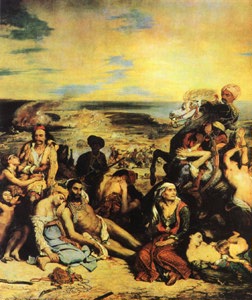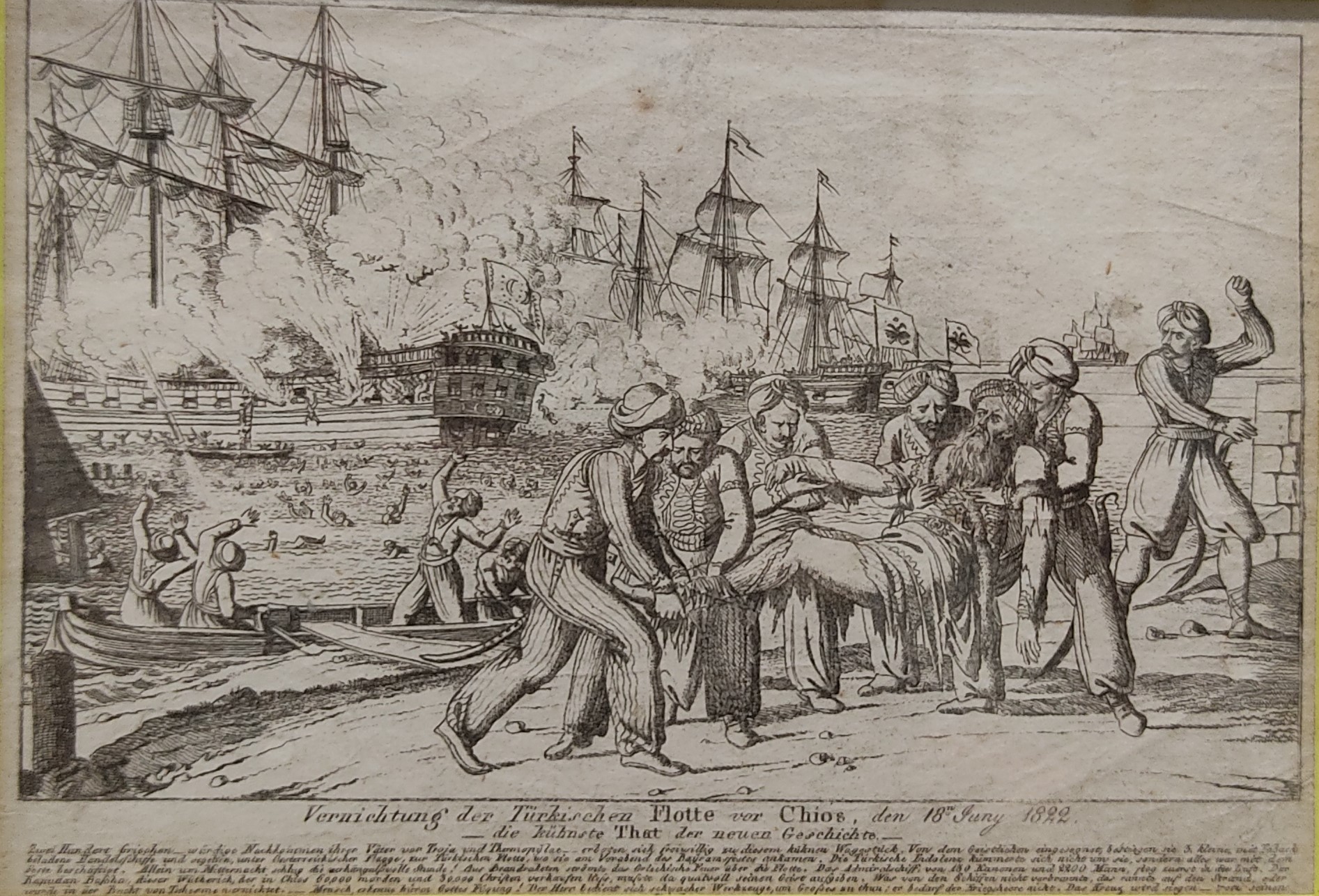

A destra il massacro a Chios (particolare) 1824, olio su tela, cm.417x354, Museo del Louvre, Parigi. A sinistra un'olio della rivolta del 1822 (Biblioteca Korais, Chios)


A destra il massacro a Chios (particolare) 1824, olio su tela, cm.417x354, Museo del Louvre,
Parigi. A sinistra un'olio della rivolta del 1822 (Biblioteca Korais, Chios)

Ferdinand-Victor-Eugene Delacroix nacque a Charenton-St-Maurice, in
Francia. Nel 1815 divenne l'allievo del pittore francese Pierre-Narcisse Guerin ed iniziò
una carriera che produsse più di 850 dipinti e moltissimi disegni, murali, ed altre
opere. Nel 1822 Delacroix espose il suo primo dipinto nell'importante salone di esibizione
Parigino: Dante e Virgilio nell' Inferno. La tecnica usata in questo dipinto sarebbe poi
stata utilizzata successivamente anche dagli Impressionisti. La successiva esposizione in
cui inserì le sue opere si tenne nel 1824 e qui presentò : Massacro a Chios. Che
mostrava una grande vivacità di colori ed emozioni ; rappresenta un episodio in cui
20,000 Greci furono uccisi dai Turchi sull'isola di Chios. Il Governo Francese lo comprò
per 6,000 franchi. L'evento per la sua efferatezza ispirò molta letteratura del primo
ottocento riportiamo un testo di di Miljan Peter Ilich ed un articolo dello Stirring Event
of History Londra 1886
Due racconti del massacro del 1822
- "On site, in time": The Massacre of Chios in 1822)
The Massacres of Chios -
A site that every Chian should study. Written and maintained by British journalist
Christopher A. Long. The site also includes a wealth of information on the genealogy of
the prominent Chian families.
Ho ricevuto è lo riporto volentieri (in inglese) da Padre Nicholas Mary, C.SS.R. questo
articolo sul Vescovo Ignazio Giustiniani durante l'invasione Turca a Chios del XIX secolo:
Bishop Giustiniani, a Child of Mary
A TRUE STORY - From the missionary annals
T he famous massacres perpetrated by the Turks on the Greek island of Chios in 1821 have
remained justly notorious and have been immortalised for posterity in art and poetry.
During the struggle for Greek independence, the Turks butchered tens of thousands of the
island’s Christian inhabitants, and the Catholic minority shared in the fate of the
schismatic majority - of the 13 000 Catholics only 300 remained alive after the slaughter.
By God’s Providence, one of their priests was preserved too. It fell to 30-year-old
Fr Ignatios Giustiniani to begin a life’s work of gathering his scattered flock,
consoling them by every means in his power them for the irreparable losses they had
sustained, and rebuilding the formerly flourishing life of the Diocese of Chios. Rome soon
realised that in this noble young priest, a descendent of the ancient and remarkable
family of the Giustiniani who, centuries before, had conquered the Island of Chios, and
given it over to the Byzantine Emperors, the Catholics of Chios had a worthy shepherd of
their souls, and he was made Bishop of the island in 1830. There he laboured until his
saintly death on 11 March 1875, in the 84th year of his age, the 61st of his priesthood,
and the 50th of his episcopal dignity. He had indeed added more lustre to the name of a
family which glories in having a canonised saint amongst its members, St Lawrence
Justinian († 1456). Bishop Giustiniani could boast of more than his noble birth and
ancient lineage; his chief praise lay in his great virtue, in his large-hearted charity
towards his fellow men, in his love of poverty and lowliness and in his untiring energy
and apostolic zeal. This latter virtue was perhaps most striking in as he went about the
task of rebuilding a diocese utterly in ruins. Disaster struck once more in 1850 as a
terrible earthquake wreaked havoc on Chios, and destroyed much of his building work.
Assisted by Divine Providence, however, he was able to build the magnificent Cathedral of
St Nicholas, several chapels, a school and a dispensary. He encouraged vocations and
invited French teaching sisters to his diocese. In all his trials he had recourse to Our
Lady, and she it was who obtained for him the strength to persevere. He himself would
relate how his efforts were furthered by miraculous intervention. “At that most
trying period,” he wrote “money was so scarce that I had no means of carrying on
the building work. In my distress, I had recourse to Our Lady. One day I heard a knock at
my door, and opening it, an unknown visitor entered and handed me a sealed packet, after
which he instantly disappeared. I felt somewhat bewildered by the sudden apparition, but
collecting myself, I opened the packet and found a picture of the Sacred Heart, with the
inscription, Beati qui confidunt in Domino - “Blessed are they who hope in the
Lord”, and 2760 pounds!” The zealous prelate had devoted himself, from the very
beginning of his episcopacy, to the work of ransoming young Greek girls who had been
carried into slavery by the Turks. There was one family of three sisters who had been thus
captured, but in spite of his enquiries, he had been unable to trace them. At length,
after recommending their sad fate very earnestly to the protection of the Mother of God,
he saw a Lady of dazzling beauty enter the church where he was praying. Coming up to
Bishop Giustiniani, she said, “Those three sisters whom you are so anxious about, are
in a Turkish harem at Chesme, in Anatolia.” She then gave him the name of their
master and the particulars of their imprisonment, and vanished. A week later the good
Bishop's messengers arrived at the place specified, on the very day when the Turkish
master of the young girls had died quite suddenly, thus making their ransom a very easy
matter. Truly, the hope of a Child of Mary will never be confounded. †
[Fr J. Keller - Maria Sanctissima ; Fr L.-E. Louvet - Les Missions Catholiques au 19ième
Siècle]

Torna alla pagina iniziale di
Enrico Giustiniani
